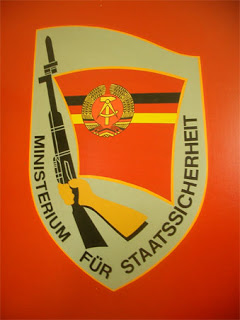Marcel Rosenbach and Holger Stark
After the fall of the Berlin Wall, the West Germans were desperate to prevent the Stasi’s top codebreakers from falling into the wrong hands and set up a company to hire the East German cryptographers. Now the former Stasi scientists develop technology used by Angela Merkel and NATO.
Every morning, while going to his office in Berlin’s Adlershof district, Ralph W. passes a reminder of his own past, a small museum that occupies a room on the ground floor of the building. The museum could easily double as a command center run by the class enemy in an old James Bond film. A display of coding devices from various decades includes the T-310, a green metal machine roughly the size of a huge refrigerator, which East German officials used to encode their telex messages.
The device was the pride of the Stasi, the feared East German secret police, which was W.’s former employer. Today he works as a cryptologist with Rohde & Schwarz SIT GmbH (SIT), a subsidiary of Rohde & Schwarz, a Munich-based company specializing in testing equipment, broadcasting and secure communications. W. and his colleagues encode sensitive information to ensure that it can only be read or heard by authorized individuals. Their most important customers are NATO and the German government.
Rohde & Schwarz is something of an unofficial supplier of choice to the German government. Among other things, the company develops bugproof mobile phones for official use. Since 2004, its Berlin-based subsidiary SIT, which specializes in encryption solutions, has been classified as a “security partner” to the German Interior Ministry, which recently ordered a few thousand encoding devices for mobile phones, at about €1,250 ($1,675) apiece. Even German Chancellor Angela Merkel has used phones equipped with SIT’s encryption technology. In other words, the Stasi’s former cryptographers are now Merkel’s cryptographers.
Secret Operation
The transfer of Ralph W. and other cryptologists from the East German Ministry for State Security, as the Stasi was officially known, to West Germany was handled both seamlessly and discreetly. West German officials were determined to make sure that no one would find out about the integration of East Germany’s top cryptologists into the west. The operation was so secret, in fact, that it has remained unknown to this day.
Only a handful of officials were involved in the operation, which was planned at the West German Interior Ministry in Bonn. In January 1991, Rohde & Schwarz SIT GmbH was founded. The company was established primarily to provide employment for particularly talented Stasi cryptologists that the Bonn government wanted to keep in key positions.
Ralph W. is one of those specialists. W., who holds a doctorate in mathematics, signed a declaration of commitment to the Stasi on Sept. 1, 1982. By the end of his time with the Stasi, he was making 22,550 East German marks a year — an excellent salary by East German standards. And when he was promoted to the rank of captain in June 1987, his superior characterized W. as one of the “most capable comrades in the collective.” While with the Stasi, W. worked in Department XI, which also boasted the name “Central Cryptology Agency” (ZCO).
Read Full Article


Be the first to comment on "Former Stasi Cryptographers Now Develop Technology for NATO"